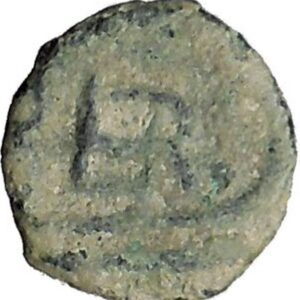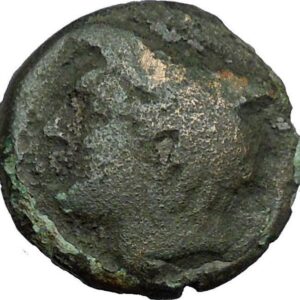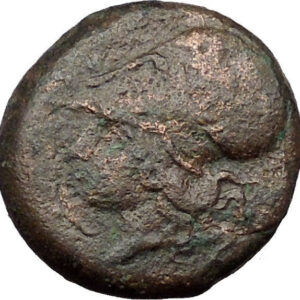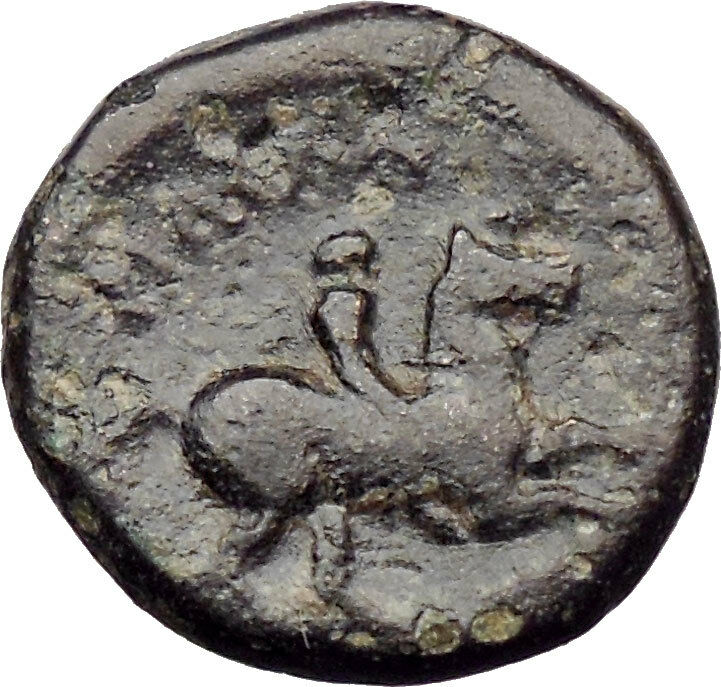|
Greek city of Amastris in Paphlagonia
Bronze 18mm (6.40 grams) Struck under Mithradates VI the Great circa 105-90 B.C. or circa 90-85 B.C.
Reference: HGC 7, 360 RARE R2; SNG Black Sea 1311
Head of ostensibly Ares in Attic helmet right.
AMAΣ-TPEΩΣ, Sword in sheath.
Founded circa 300 B.C. on the site of the former Sesamos, Amastris became an important city and Black Sea port.
You are bidding on the exact item pictured, provided with a Certificate of Authenticity and Lifetime Guarantee of Authenticity.
 Ares is the Greek god of war. He is one of the Twelve Olympians, and the son of Zeus and Hera. In Greek literature, he often represents the physical or violent aspect of war, in contrast to the armored Athena, whose functions as a goddess of intelligence include military strategy and generalship. Ares is the Greek god of war. He is one of the Twelve Olympians, and the son of Zeus and Hera. In Greek literature, he often represents the physical or violent aspect of war, in contrast to the armored Athena, whose functions as a goddess of intelligence include military strategy and generalship.
The Greeks were ambivalent toward Ares: although he embodied the physical valor necessary for success in war, he was a dangerous force, “overwhelming, insatiable in battle, destructive, and man-slaughtering.” Fear (Phobos) and Terror (Deimos) were yoked to his battle chariot. In the Iliad his father Zeus tells him that he is the god most hateful to him. An association with Ares endows places and objects with a savage, dangerous, or militarized quality. His value as a war god is even placed in doubt: during the Trojan War, Ares was on the losing side, while Athena, often depicted in Greek art as holding Nike (Victory) in her hand, favored the triumphant Greeks.
Ares plays a relatively limited role in Greek mythology as represented in literary narratives, though his numerous love affairs and abundant offspring are often alluded to. When Ares does appear in myths, he typically faces humiliation. He is well known as the lover of Aphrodite, the goddess of love who was married to Hephaestus, god of craftsmanship, but the most famous story involving the couple shows them exposed to ridicule through the wronged husband’s clever device.
The counterpart of Ares among the Roman gods is Mars, who as a father of the Roman people held a more important and dignified place in ancient Roman religion for his agricultural and tutelary functions. During the Hellenization of Latin literature, the myths of Ares were reinterpreted by Roman writers under the name of Mars. Greek writers under Roman rule also recorded cult practices and beliefs pertaining to Mars under the name of Ares.  Thus in the classical tradition of later Western art and literature, the mythology of the two figures becomes virtually indistinguishable. Thus in the classical tradition of later Western art and literature, the mythology of the two figures becomes virtually indistinguishable.
Mithridates VI or Mithradates VI (Greek: Μιθραδάτης), from Old Persian Mithradatha, “gift of Mithra”; 134-63 BC, also known as Mithradates the Great (Megas) and Eupator Dionysius, was king of Pontus and Armenia Minor in northern Anatolia (now Turkey) from about 120-63 BC. Mithridates is remembered as one of the Roman Republic’s most formidable and successful enemies, who engaged three of the prominent generals from the late Roman Republic in the Mithridatic Wars: Lucius Cornelius Sulla, Lucullus and Pompey. He was also the greatest ruler of the Kingdom of Pontus.
 Amasra (from Greek Amastris Ἄμαστρις, gen. Ἀμάστριδος) is a small Black Sea port town in the Bartın Province, Turkey. The town is today much appreciated for its beaches and natural setting, which has made tourism the most important activity for its inhabitants. In 2010 the population was 6,500. Amasra (from Greek Amastris Ἄμαστρις, gen. Ἀμάστριδος) is a small Black Sea port town in the Bartın Province, Turkey. The town is today much appreciated for its beaches and natural setting, which has made tourism the most important activity for its inhabitants. In 2010 the population was 6,500.
Amasra has two islands: the bigger one is called Büyük ada (Great Island) while the smaller one is called Tavşan adası (Rabbit Island).
History
Situated in the ancient region of Paphlagonia, the original city seems to have been called Sesamus (Greek: Σήσαμος), and it is mentioned by Homer in conjunction with Cytorus. Stephanus says that it was originally called Cromna; but in another place, where he repeats the statement, he adds, as it is said; but some say that Cromna is a small place in the territory of Amastris, which is the true account. The place derived its name Amastris from Amastris, the niece of the last Persian king Darius III, who was the wife of Dionysius, tyrant of Heraclea, and after his death the wife of Lysimachus. Four small Ionian colonies, Sesamus, Cytorus, Cromna, also mentioned in the Iliad,[6] and Tium, were combined by Amastris, after her separation from Lysimachus, to form the new community of Amastris, placed on a small river of the same name and occupying a peninsula. According to Strabo, Tium soon detached itself from the community, but the rest kept together, and Sesamus was the acropolis of Amastris. From this it appears that Amastris was really a confederation or union of three places, and that Sesamus was the name of the city on the peninsula. This may explain the fact that Mela mentions Sesamus and Cromna as cities of Paphlagonia, while omitting Amastris.
The territory of Amastris produced a great quantity of boxwood, which grew on Mount Cytorus. Its tyrant Eumenes presented the city of Amastris to Ariobarzanes of Pontus in c. 265-260 BC rather than submit it to domination by Heraclea, and it remained in the Pontic kingdom until its capture by Lucius Lucullus in 70 BC in the second Mithridatic War. The younger Pliny, when he was governor of Bithynia and Pontus, describes Amastris, in a letter to Trajan, as a handsome city, with a very long open place (platea), on one side of which extended what was called a river, but in fact was a filthy, pestilent, open drain. Pliny obtained the emperor’s permission to cover over this sewer. On a coin of the time of Trajan, Amastris has the title Metropolis. It continued to be a town of some note to the seventh century of our era. From Amasra got its name an important place of Constantinople, the Amastrianum.
The city was not abandoned in the Byzantine Era, when the acropolis was transformed into a fortress and the still surviving church was built. It was sacked by the Rus during the First Russo-Byzantine War in the 830s. Speros Vryonis states that in the 9th century a “combination of local industry, trade, and the produce of its soil made Amastris one of the more prosperous towns on the Black Sea.” In the 13th century Amasra exchanged hands several times, first becoming a possession of the Empire of Trebizond in 1204, then at some point in the next ten years being captured by the Seljuk Turks, until finally in 1261, in her bid to monopolize the Black Sea trade, the town came under the control of the Republic of Genoa. Genoese domination ended when the Ottoman Sultan Mehmed II conquered the whole Anatolian shores of the Black Sea.
The bishopric of Amastris was established early: according to Eusebius, its congregation received a letter from the second-century bishop, Dionysius, Bishop of Corinth, wherein he names their bishop, one Palmas. The see was initially a suffragan of the metropolitan of Gangra, capital of the Roman province of Paphlagonia, but in the late 8th century its bishop obtained from the Byzantine Emperor its elevation to the rank of autocephalous archeparchy. It is listed as such in the Notitia Episcopatuum attributed to Basil the Armenian (c. 840) and in that of Leo VI the Wise (early 10th century). In the middle of the 10th century it obtained the rank of metropolitan see without suffragans, a rank it held until, due to the diminution in the number of Christians in the area, it was suppressed. From the 14th century to the second half of the 15th, the town was also the seat of a bishopric of the Latin Church. No longer a residential bishopric, Amastris is today listed by the Catholic Church as a titular see.
Main sights
With its architectural heritage, Amasra is a member of the Norwich-based European Association of Historic Towns and Regions.
Archaeological Museum: there is a fine medium-sized archaeological museum by the sea with remains from both land and underwater. Of particular interest is a statue of the snake god Glykon, a fraudulent creation of a local entrepreneur during Roman imperial times.
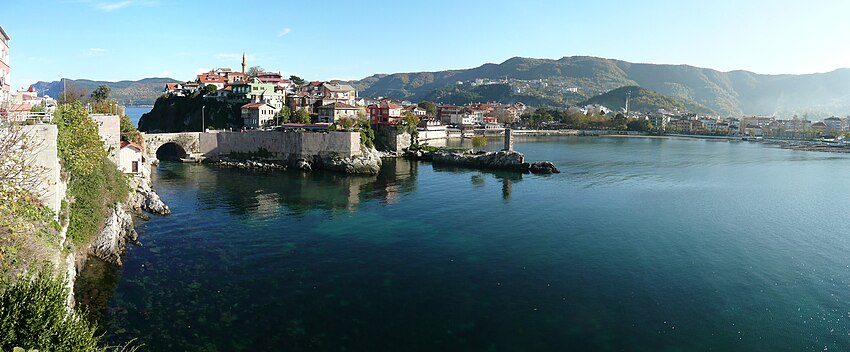
Panoramic view of the town
Amasra Castle
Amasra Castle was built during the Roman period. The walls of the castle were built by the Byzantines. The front walls and gates were built by the Genoese in the 14th and 15th centuries. Though located on a narrow peninsula, a tunnel under the castle leads to a fresh water pool.
Church Mosque
Built as a Byzantine church in the 9th century AD. The church is a small chapel and its narthex section consists of three parts. After Fatih Sultan Mehmet conquered Amasra in 1460, it was converted to a mosque. The church mosque was closed to prayer in 1930.

Amasra church mosque
Bird’s Rock Road Monument
Bird’s Rock Road Monument was created between AD 41-54 by order of Bithynia et Pontus Governor Gaius Julius Aquila. It was a resting place and monument. At the time when Claudius was Rome’s Emperor, Aguila was the commander of the building army in the eastern provinces. It is located a little outside Amasra on the road in, it is easily accessed by steps leading from the roadside.

Bird’s Rock Road Monument
Power Station
In 2009 a coal-fired power station of 2640 MWe (or 1200 MWe) was proposed. It will have a super critical boiler, will utilise a nearby bituminous coal mine and is to be seawater cooled. An application has been made to acquire 49-year long-term concession rights for exploitation of local bituminous proven coal reserves of approximately 573 million metric tons. Concerns have been raised about the effect on air quality, marine ecology and ash
|





 Ares is the Greek god of war. He is one of the Twelve Olympians, and the son of Zeus and Hera. In Greek literature, he often represents the physical or violent aspect of war, in contrast to the armored Athena, whose functions as a goddess of intelligence include military strategy and generalship.
Ares is the Greek god of war. He is one of the Twelve Olympians, and the son of Zeus and Hera. In Greek literature, he often represents the physical or violent aspect of war, in contrast to the armored Athena, whose functions as a goddess of intelligence include military strategy and generalship. Thus in the classical tradition of later Western art and literature, the mythology of the two figures becomes virtually indistinguishable.
Thus in the classical tradition of later Western art and literature, the mythology of the two figures becomes virtually indistinguishable. Amasra (from Greek Amastris Ἄμαστρις, gen. Ἀμάστριδος) is a small Black Sea port town in the Bartın Province, Turkey. The town is today much appreciated for its beaches and natural setting, which has made tourism the most important activity for its inhabitants. In 2010 the population was 6,500.
Amasra (from Greek Amastris Ἄμαστρις, gen. Ἀμάστριδος) is a small Black Sea port town in the Bartın Province, Turkey. The town is today much appreciated for its beaches and natural setting, which has made tourism the most important activity for its inhabitants. In 2010 the population was 6,500.




